The Uyuni Salt Flats had been on our family travel wish list since the early planning stages of our world trip. We’d seen the surreal photos—mirror reflections in the rainy season, perspective-defying poses, endless blinding white—and couldn’t wait to experience it ourselves. What we didn’t expect was how much more this tour would offer: cactus-covered islands, flamingo-filled lagoons, geysers at sunrise, and the strange beauty of Bolivia’s high-altitude landscapes. It wasn’t always comfortable, but it was unforgettable.
Here’s a look at how our Salar de Uyuni adventure unfolded—from chilly arrivals, to sparkling landscapes and spectacular hot springs.

Day 1: Arriving in Uyuni
Despite the comfortable seats on our overnight bus from Sucre, we had little sleep and arrived in Uyuni at 4:30 a.m. with nowhere to go. We took a taxi to our hostel, hoping they’d let us in early—even just to crash in the lobby. Thankfully, the host was incredibly kind and found a small room to rest in until our room was ready.
That morning was bitterly cold, and our temporary room had no heat. We huddled together in a single bed, relying on body heat and layers to stay warm.
Once rested, we realized we would need warmer clothes if we had any chance of surviving the Salt Flats. A quick shopping trip yielded tuques, mittens, and thick fuzzy socks. We spent the rest of the day exploring the quiet streets of Uyuni and getting some real rest before the big adventure.
Tip: Don’t miss Minute Man Pizza, a cozy spot near the town centre serving excellent pizza and hot apple cider—perfect after a chilly walk.
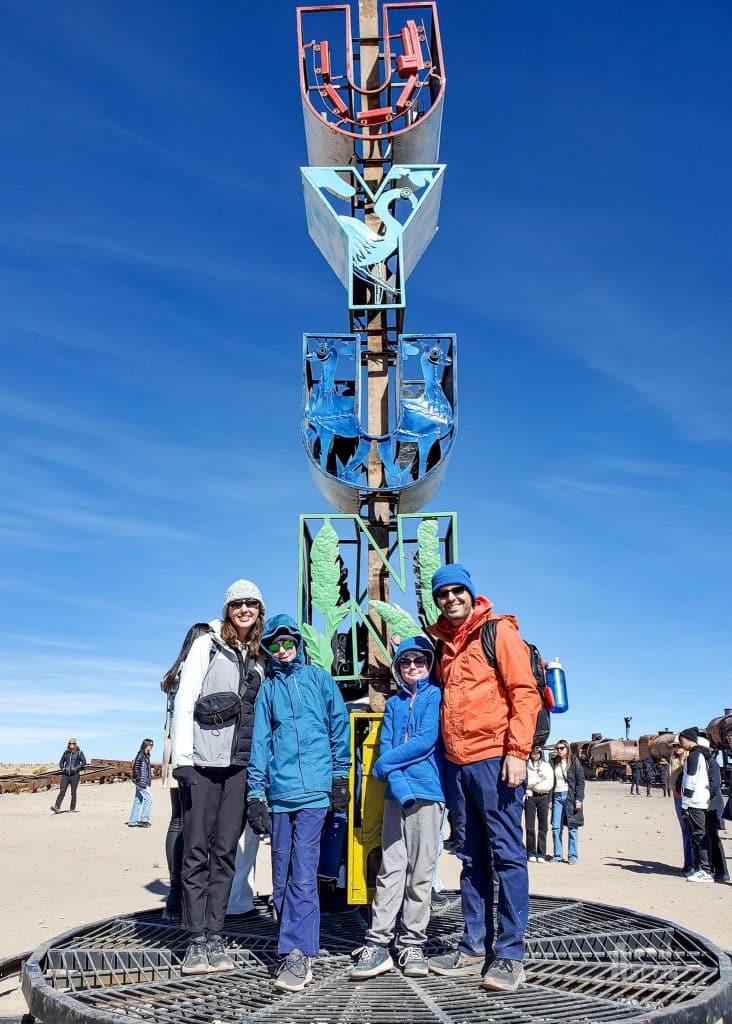
Day 2: Salt Flats & Cactus Island
We kicked off our tour with a stop at the Cementerio de Trenes (Train Cemetery), where the boys enjoyed climbing on rusted-out engines. We all marvelled at the eerie, photogenic ruins set against a big Bolivian sky.

As we continued toward the Salt Flats, the landscape turned blindingly white, stretching endlessly in all directions. At times, it looked like the Arctic, but instead of snow, it was salt: thick, sparkling, and patterned with geometric cracks.
A visit to the Hotel de Sal—a hotel built entirely of salt—offered a warm reprieve from the brisk air. The salt bricks insulated surprisingly well, and the novelty of walking on a floor that crunched beneath our feet was a hit with the kids.

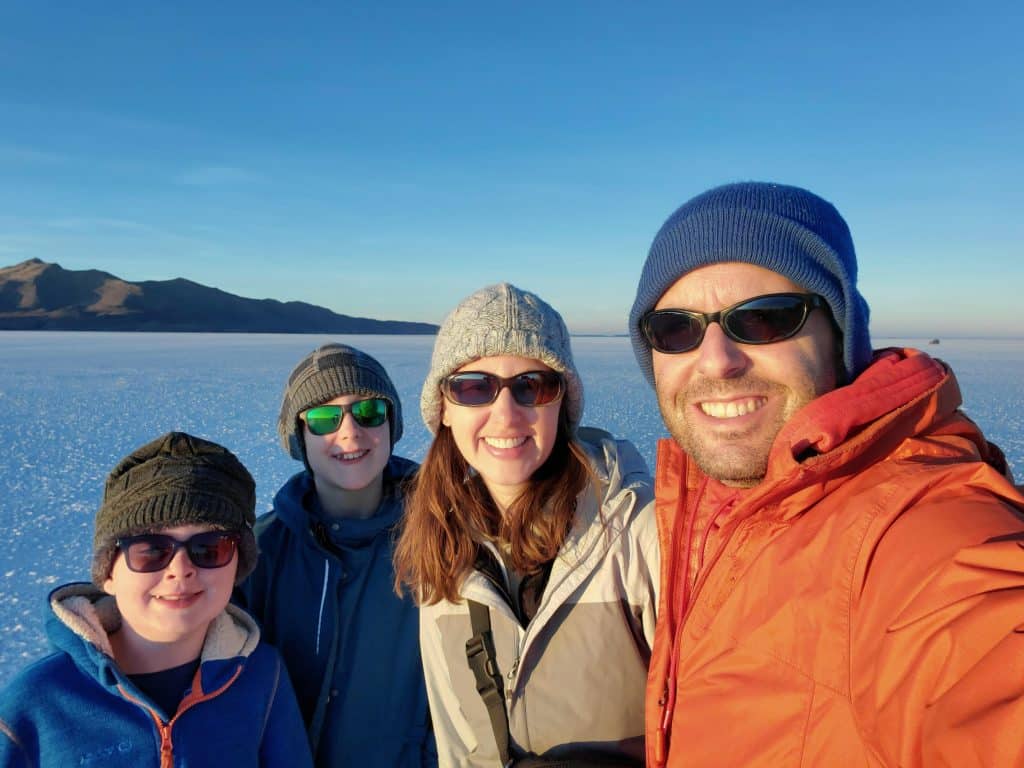
After lunch, it was time for the classic Uyuni photos. We had a blast setting up goofy perspective shots—the kids “stomping” on us and taking pictures with their stuffed animals, and Mason had to lick the ground to see if it was really salty (it was!).
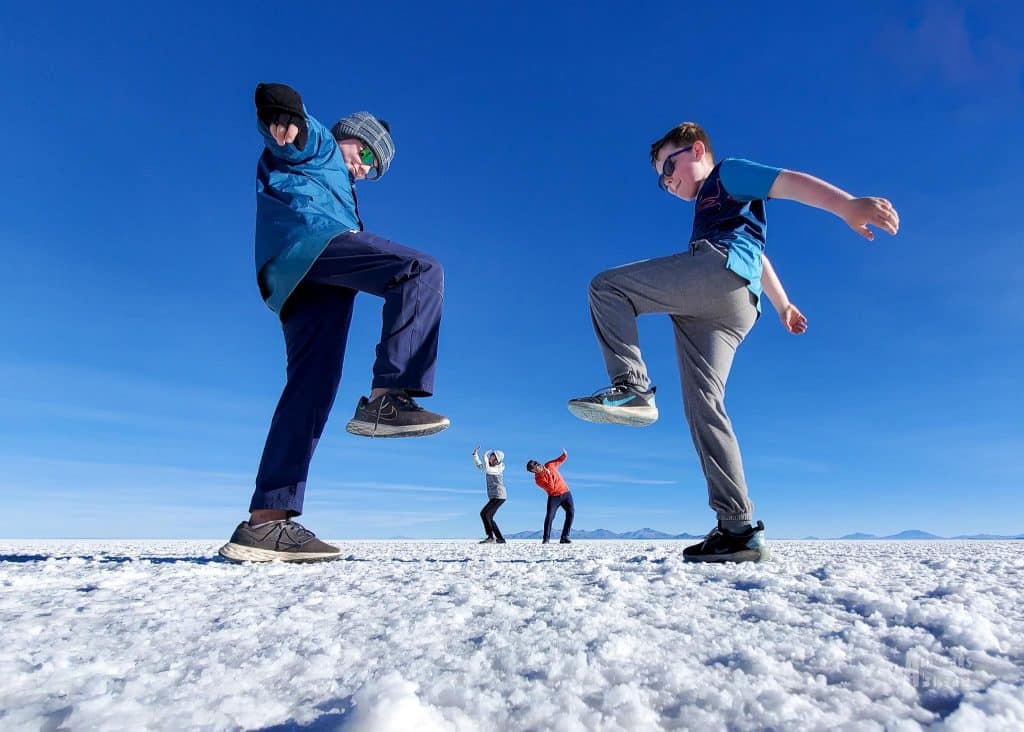

From the sea of white, a patch of green eventually appeared, Isla Incahuasi (Cactus Island), a rocky hill made of petrified coral and dotted with ancient cacti. Once part of a prehistoric ocean, this island offers incredible views of the salt flats from the top. The hike was manageable and well worth it.
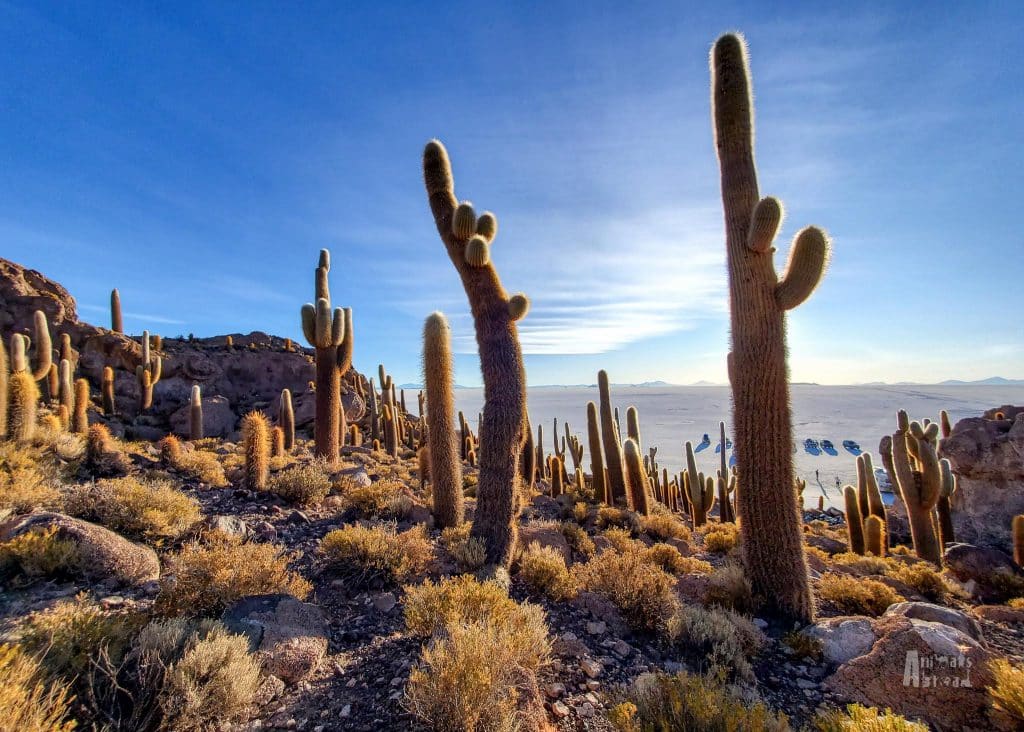
We ended the day in Atulcha, watching the sun set over the vast, empty flats. Our silhouettes against the colourful, fading sky made for some of the most stunning photos of the trip.
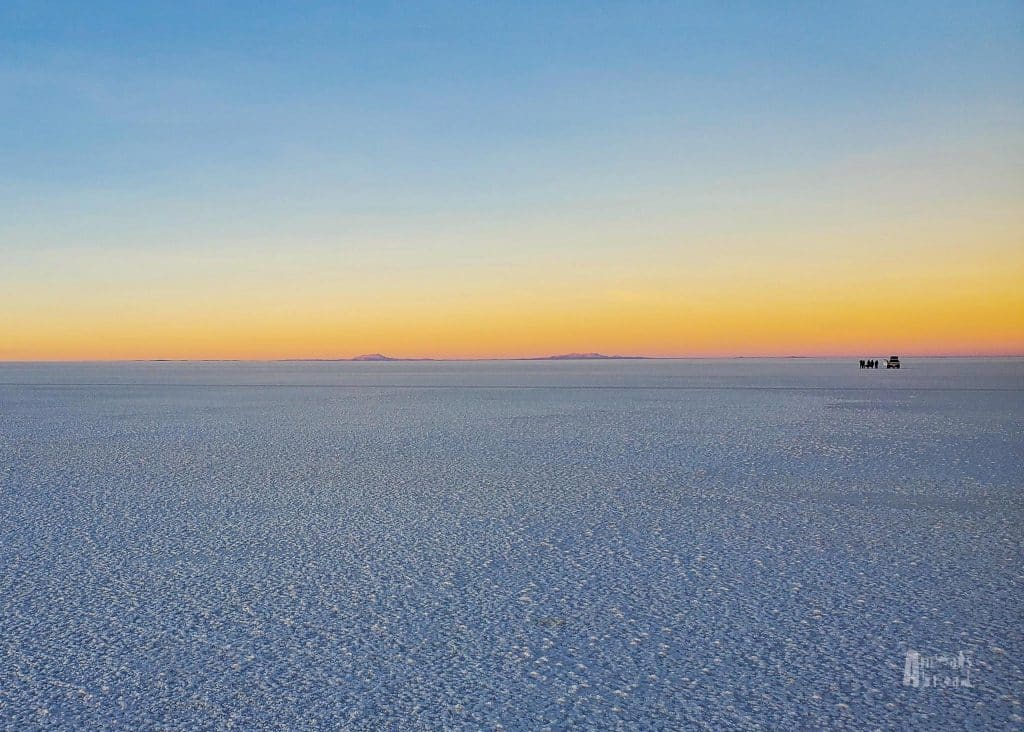
Day 3: Flamingos and Otherworldly Landscapes
Day three involved lots of hopping in and out of the car, but the stops were worth it:
• Mirador Volcán Ollagüe: A scenic viewpoint framed by volcanoes and remnants of heritage train tracks.
• Laguna Verde (Green Lake): Turquoise water contrasted with pink flamingos, walking on ice, was a magical sight.
• Árbol de Piedra (Stone Tree): A famous wind-sculpted rock formation where we spotted viscachas (adorable rabbit-like creatures).
• Laguna Colorada (Red Lake): Wind-blasted and raw, this bright lake was starkly beautiful, though the cold kept our visit short.
The altitude and exposure made this day more tiring, especially with strong gusts of wind at every stop.
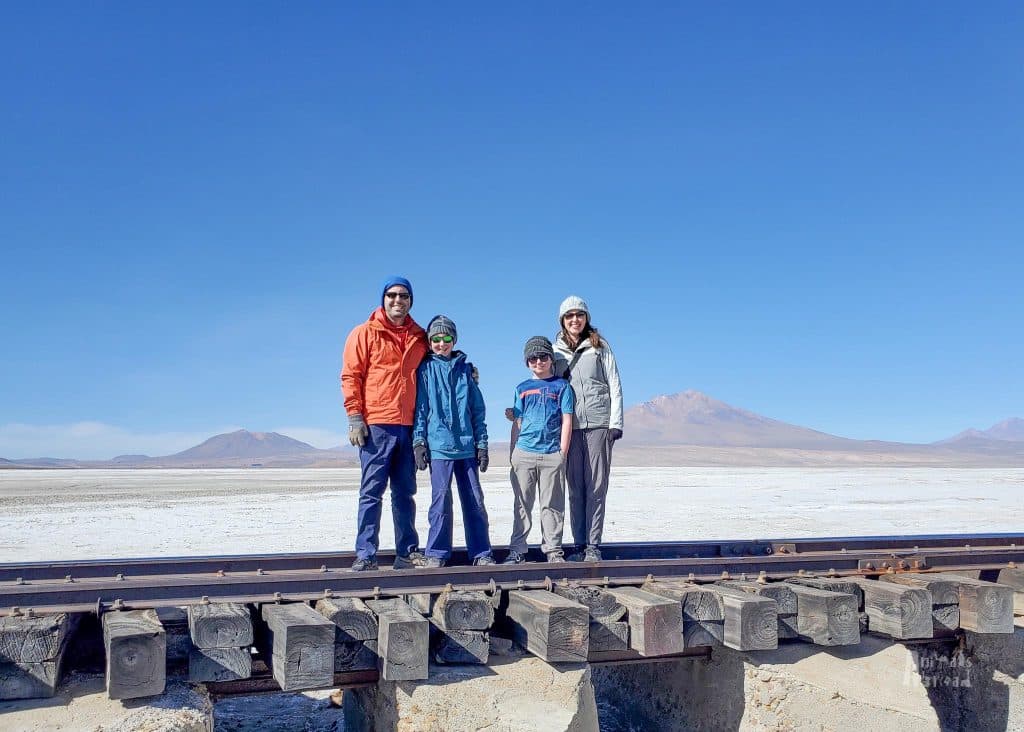



Day 4: Geysers, Hot Springs & Valle de Roca
We were up before dawn to visit Sol de Mañana, a geothermal area of boiling mud and steaming geysers. At nearly 4,900 metres (16,000 feet), this was the highest point of our tour—and it hit hard. Mason experienced nausea and a headache, but coca lozenges helped ease the symptoms. The bubbling geysers were mesmerizing but hard to enjoy for long due to the bitter cold.

The reward came shortly after: a soak in natural hot springs surrounded by highland mountains. It felt surreal to be warm again while watching steam rise into the crisp morning air.
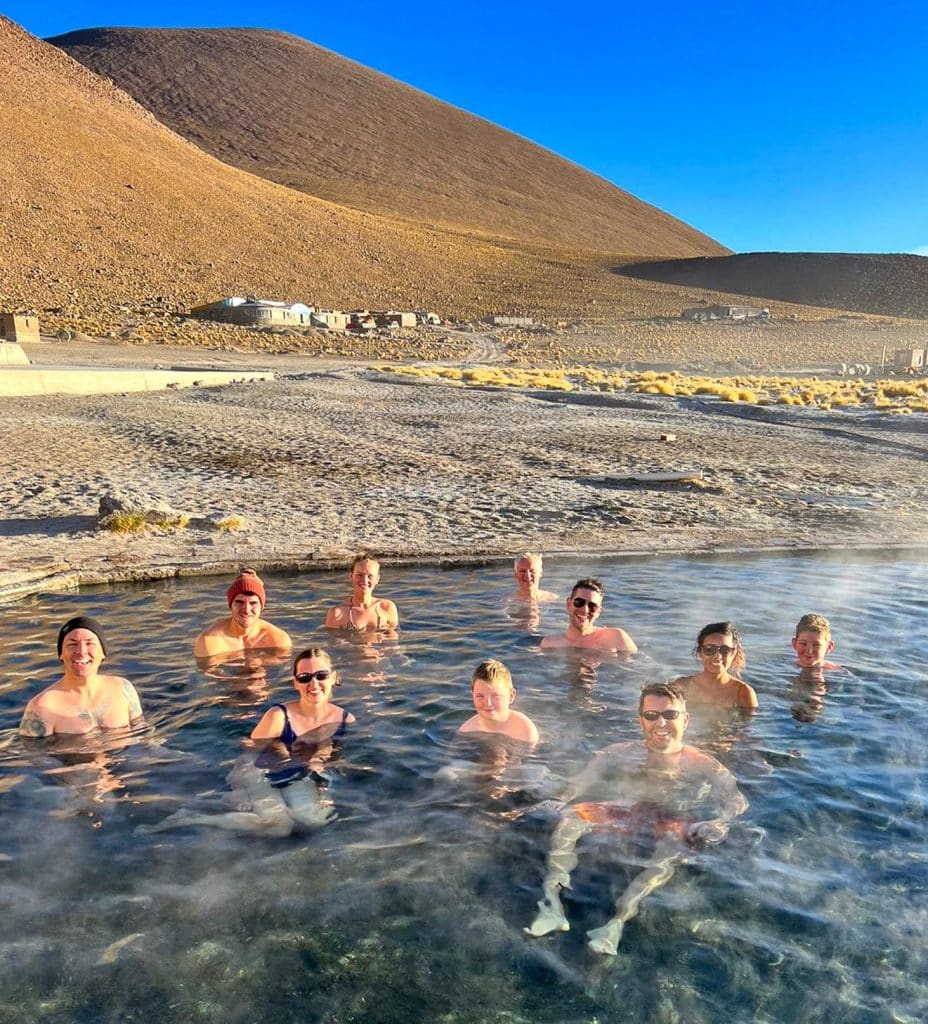
Our final stop was Valle de Roca, a playground of massive rock formations perfect for climbing and creative play. The boys loved imagining creatures in the shapes of the stones.
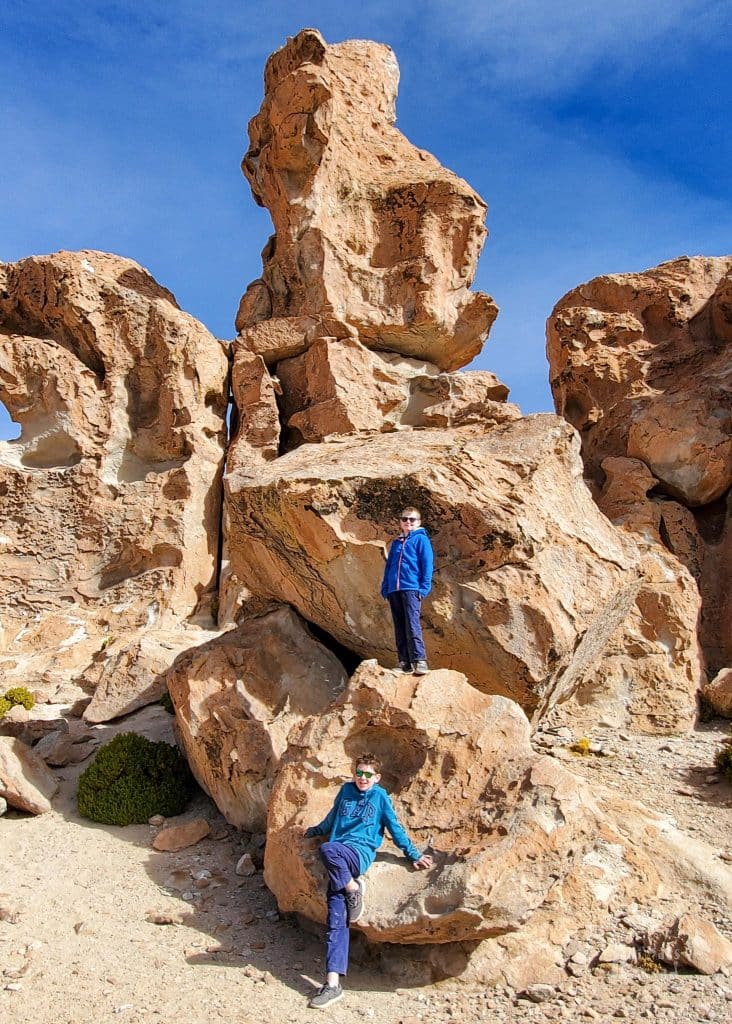
By 6 p.m., we were back in Uyuni and headed straight for Minute Man Pizza one last time. After dinner, we boarded the overnight bus to La Paz.
Where We Stayed
We stayed in two different hostels—both basic but clean. One had a private bathroom, the other a shared one. Neither had heating. During the day, the sun helped warm us up, but once it set, the temperature dropped sharply. We slept in layers with all our clothes on under piles of blankets, which somehow worked.
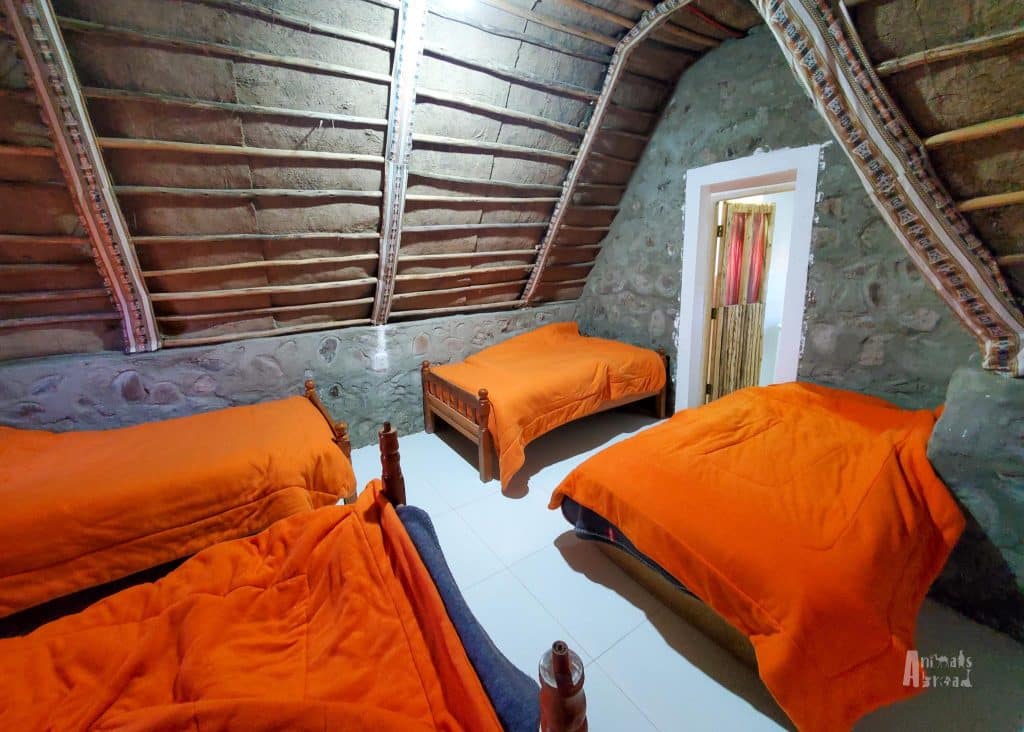
Practical Tips for Your Uyuni Tour
Booking the Tour: We chose a 3-day, 2-night tour with Perla Bolivia and had a great experience. Most companies follow similar routes, but it’s worth checking reviews and amenities (like oxygen availability) before booking.
With Kids? Consider an Extra Night in Uyuni: Many travellers arrive on the overnight bus and start their tour that same morning, but this is tough on kids. Booking a hostel and resting the day before made a huge difference for our family.
Pack for the Cold: The sun can be deceiving even during the day. Nighttime temperatures can dip below -10°C, and accommodations on the tour have no heat. Bring warm clothes, a good hat, mittens, and thick socks.
Be Altitude Aware: The tour reaches altitudes higher than La Paz. Make sure your family is well acclimatized before departing. Some companies carry oxygen; ours checks oxygen levels nightly. For tips on altitude sickness check out, Breathless in Bolivia: Managing Altitude Sickness as a Family.

Getting to Uyuni
We took an overnight bus from Sucre to Uyuni (and later from Uyuni to La Paz)—our only bus journeys in Bolivia. While the reclining seats and footrests were designed for sleep, the ride was far from restful.
Bolivia is known for its treacherous roads and often hazardous driving conditions. The overnight bus sped through the mountain passes, hugging cliffside roads with dizzying drops. I eventually closed my eyes and tried to sleep—not because I was tired, but because watching the outside world fly by at high speeds was too nerve-racking.
Tips for Surviving the Bus:
• Use the bathroom beforehand: Bus bathrooms quickly become unpleasant due to overuse and bumping roads, causing toilet water to spill on the floor.
• Take motion sickness meds: The winding roads and high speeds can trigger nausea.
• Keep valuables close: When we arrived back in La Paz, I discovered my backpack, which was stored under the footrest, had been rummaged through. My laptop, tablet, and sunglasses were literally stolen right from under my feet!
• Book a room for early arrival: Uyuni is freezing before sunrise, and most check-ins aren’t until after lunch. A morning nap can save the day.
Uyuni Adventures
Our Uyuni Salt Flats tour was a highlight of our time in Bolivia. It was raw, rugged, and not always comfortable, but it gave us a front-row seat to some of the most spectacular landscapes on earth. From salt deserts to flamingo-filled lakes and boiling geysers to cactus-covered islands, the experience felt like visiting another planet. And seeing it all through our kids’ eyes—curious, excited, and completely in awe—made it even more magical. Just remember to pack warm clothes, go slow with the altitude, and expect the unexpected.

Ready to Explore Bolivia?
Check out these related posts to help plan your trip:
• Bolivia with Kids: A 27-Day Itinerary
• Family Guide to La Paz: A Flexible 5-Day Itinerary
• Travelling to the Amazon: An Adventure in Itself
• Exploring Bolivia’s Amazon: Pampas and Madidi National Park
• Chasing Jaguars in Bolivia: A Family Safari in Jaguarland
• Visiting Toro Toro National Park: Know Before You Go

